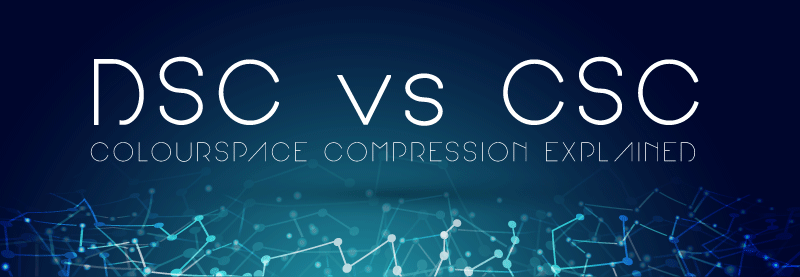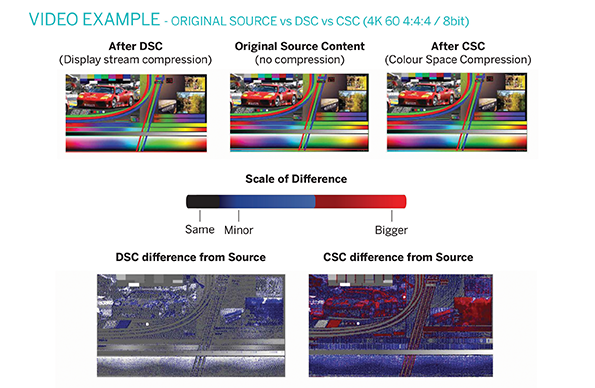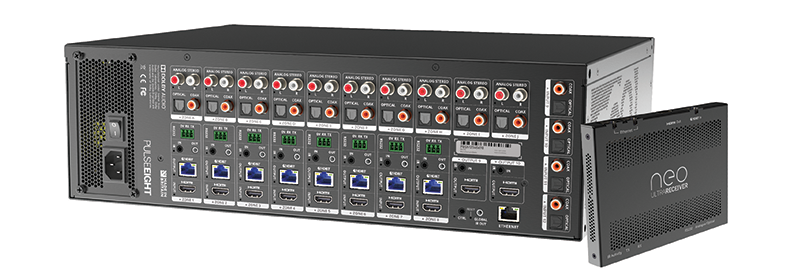WHITEPAPER
DSC vs CSC
MARCH 2022
In this paper, our Business Development Director, Jonathan Regalado-Hawkey discusses the importance of using DSC compression.
Estimated Reading Time: 8 minutes

It's fair to say that the last few years have been a
challenge and the AV distribution residential market has experienced some big
changes. However, despite economic difficulties and the manner in how end-users
consume content, it's still managed to continue to grow.
Despite AV over IP technology taking the industry by storm,
for wired connectivity, HDBaseT™ has remained the most popular technology of
choice for many professional Residential AV installers due to its end-to-end
reliable performance and simplicity.
HDBaseT™ supports extension of full digital audio, HDMI®
uncompressed video, 100Mb Ethernet, power, RS-232 and IR control over a single
CAT5e cable, up to 100m. However, there has been a steady shift from extending
HD resolutions to 4K (UHD) video without any noticeable effect on new HDBaseT™
installations. That is until HDR content is considered.
"DSC has become the de-facto compression standard for ultra-low latency compression"
What is DSC?
Display Stream Compression (DSC) is a well recognised
compression mechanism developed by VESA, an international trade association
driving video standard initiative. Unlike other well-known and older compression standards in
the industry such as H264, H265 and JPEG2000 to name a few, DSC technology
utilises very light and efficient compression ratio (2:1 or 3:1) to provide a
true visually lossless performance.
DSC has become the de-facto compression standard for
ultra-low latency compression and has been adopted by major display interfaces
including DisplayPort, HDMI®, MIPI and MHL.
Some other benefits of DSC include that it removes the need
for lossy techniques such as Colour Space Conversion (4:4:4 to 4:2:2/4:2:0) and
reducing colour depth (bit dithering).
What is CSC?
Colour Space Conversion (CSC)—or more precisely, chroma
sampling—is a video technique that reduces bandwidth required by a video signal
by maintaining the luminance data but lowers the colour information. This
technique was developed in the 1950's, along with colour encoding to support
the shift from black-and-white television broadcast to the introduction on
colour.
The proven theory behind this technique is that the human eye is much
more sensitive to changes in the shapes and contracts (luminance) than colour.
However, when the technique is utilised in a digital transmission, it
effectively reduces the pixel chroma bits (up 50% in 4:4:4—>4:2:0) which is
information that can't be recovered at the RX side.

Comparing DSC VS CSC
Display Stream Compression (DSC) standard was released in
2015 and quickly became an industry leading CODEC, recognised for delivering
"visually lossless" mezzanine compression. Whereas CSC is an
effective but simpler video technique that lowers bandwidth by reducing the
amount of chroma information, which is unrecoverable. Below are some
comparisons on video quality of the same source when comparing the two
technologies.
Colour Depth and High Dynamic Range
Colour depth is the number of bits per colour in a pixel.
The standard video resolution distributed over HDMI® and DisplayPort has been
default set at 8-bits per colour (24-bit per pixel); which translates as 8 bits
of luminance (L), 8 bits of chroma red (Cr) and 8 bits of chroma blue (Cb).
There has been an increase in higher colour depths
(10/12/14/16-bits per colour) otherwise known as "DeepColour" over
the last few years, supported by HDMI® since their specification version 1.3 was
released in 2006.
The importance of higher colour depths is significant as it
provides millions of more colours along with better gradients and significantly
improved image quality, e.g. reducing those dreaded "banding" effects
in a sunset picture.
High Dynamic Range
Over the last few years, the latest production and recording
techniques have offered further visual enhancements such as wider contrast,
colour and brightness. These are generally classed as High Dynamic Range (HDR).
Currently, the most widely adopted HDR standard on the
market is HDR10/HDR12. This requires a colour depth of at least 10-bits and
12-bits per colour respectively. There are other leading HDR standards that
have rapidly been adopted across the industry such as HLG, HDR10+ or Dolby
Vision, to name a few.
It's important to note that HDR content has been readily
available in the past few years with new content coming from Sky, Netflix,
Prime Video and others.
Colour Bit Dithering
Colour Bit Dithering is a technique employed to reduce the
colour depth of an image to decrease the link bandwidth required. The technique
"throws away" the least significant colour bits (up to 33% bit saving
when going from 12-bit to 8-bit) which is information that can't be recovered
at the RX.
Bit Dithering greatly affects image quality when reduced
below 10-bits per colour, much more than colour space conversion (CSC), because
it affects the luminance of the picture. More importantly, HDR
relies on 10-bit per colour and above so any bit dithering will affect the HDR
content itself.
From an installation point of view, it's important to ensure
that any video extension equipment being used is not utilising bit dithering
techniques as this will ensure that the 4K HDR video content isn't displayed on
the screen as intended.
Testing visualization was conducted with the comparison tool “Beyond Compare”. The “image compare” view shows images side-by-side with their differences highlighted.
HDBaseT™ 2.0 + DSC
HDMI® 2.0 video resolutions (e.g. 4K@60/4:4:4/8-bit,
4K@60/4:2:2/10-bit) require ~ 18Gbps data rate, which means current HDBaset™
1.0/2.0 solutions are only able to support up to ~9Gbps and do not have
sufficient bandwidth.
There are HDBaseT™ extension products in the market claiming
"proprietary visually-lossless compression mechanisms" which rely on
CSC and bit dithering to lower the video data required over HDBaseT™ link- e.g.
4K60/4:2:2/10bit (18Gbps)--> 4K60/4:2:0/8bit (8Gbps).
However, as we've seen, these products remove crucial
luminance and colour information and provide poor quality compression that is
damaging the image in a 4K HDR extension.
The only HDBaseT™ compliant mechanism to achieve HDMI® 2.0
resolutions (18Gbps) over HDBaseT 2.0 link (8Gbps) is by using DSC technology-
described as "HDBaseT™ 4K60 Type A".
By using equipment capable of supporting HDBaseT™ 4K60 Type
A (DSC), it ensures backwards compatibility when connected to a standard with
HDBaseT™ 2.0/1.0 (non-DSC).
The Future of 8K
And what about 8K? It's fair to say that there has been some
marketing noise around the future of 8K with the release of HDMI® 2.1. However,
it's unlikely that 8K resolution will become prevalent in consumer homes any
time soon, or at least not until 8K content becomes readily available. It will
come, but we are not there yet.
There are also some limitations to consider such as the much
higher bandwidth required for supporting 8K resolutions and that even the
latest advances in connectivity and technologies such as HDBaseT3 are still not
able to cope with these new increases in bandwidth. Mezzanine compression
techniques such as DSC, are likely to continue playing a key part when bridging
this 'bandwidth gap' without affecting the picture quality.
With the advancing times, comes advancing
technology however, for the time being, 4K is here to stay and 8K is the
future.
Testing visualization was conducted with the comparison tool “Beyond Compare”. The “image compare” view shows images side-by-side with their differences highlighted.
The Pulse-Eight Advantage
As discussed, the only compression that HDBaseT™ will
certify is DSC, which is another reason why Pulse-Eight will only use DSC in
our HDBaseT products. The first product Pulse-Eight released using DSC was the
neo:Ultra HDMI® Extender Set which is capable of 4K/60, 4:4:4, 8bit or 4K/60
4:2:2, 12bit up to 100m.
Following on from this, Pulse-Eight released their first
audio and video matrix, yet again utilising DSC to ensure maximum distances for
full 4K. The neo:X also features 8 HDMI® inputs, 8 HDBaseT™ outputs and 2 HDMI®
outputs, alongside a fully integrated 10 zone audio matrix.
We've also released a range of "Made for Binary"
4K matrices, available exclusively through Snap One.
Pulse-Eight are a Contributing member of the
HDBaseT™ Alliance and active participant in several of their technical working
groups, allowing for a special and deep understanding of the technology when
developing our products. This relationship with the standard allows Pulse-Eight
to create powerful diagnostic tools. Be it LED to indicate that the cable is
longer than maximum transmission distance or the real-time HDBaseT™ link
quality test to ensure that the installation is running perfectly before
leaving site or even monitored remotely through our portal- all innovative
ideas are created right here in Britain.

Conclusion
So...does your video extension equipment truly support 4K
HDR? It's important that when choosing video extension equipment, you
understand the technology inside the equipment as the product's specification
sheet doesn't always tell the full story. Terms such as "proprietary
compression" can sometimes be vague and lacking in detail, and this is
usually for a reason!
Here at Pulse-Eight, our in-house expert team of engineers
take great pride in carefully analysing and choosing the technological
standards that are then designed into our products, ensuring that we truly
deliver the best quality without compromise.
Jonathan Regalado-Hawkey
BUSINESS DEVELOPMENT DIRECTOR
Jonathan has over 14 years experience in the semiconductor and ProAV industry. He has participated in all aspects of technical system architecture, customer support and sales. Over the years, he has developed long-term business relationships and is well regarded amongst industry luminaries.
References
With thanks to Silora R&D (www.silrd.com)


